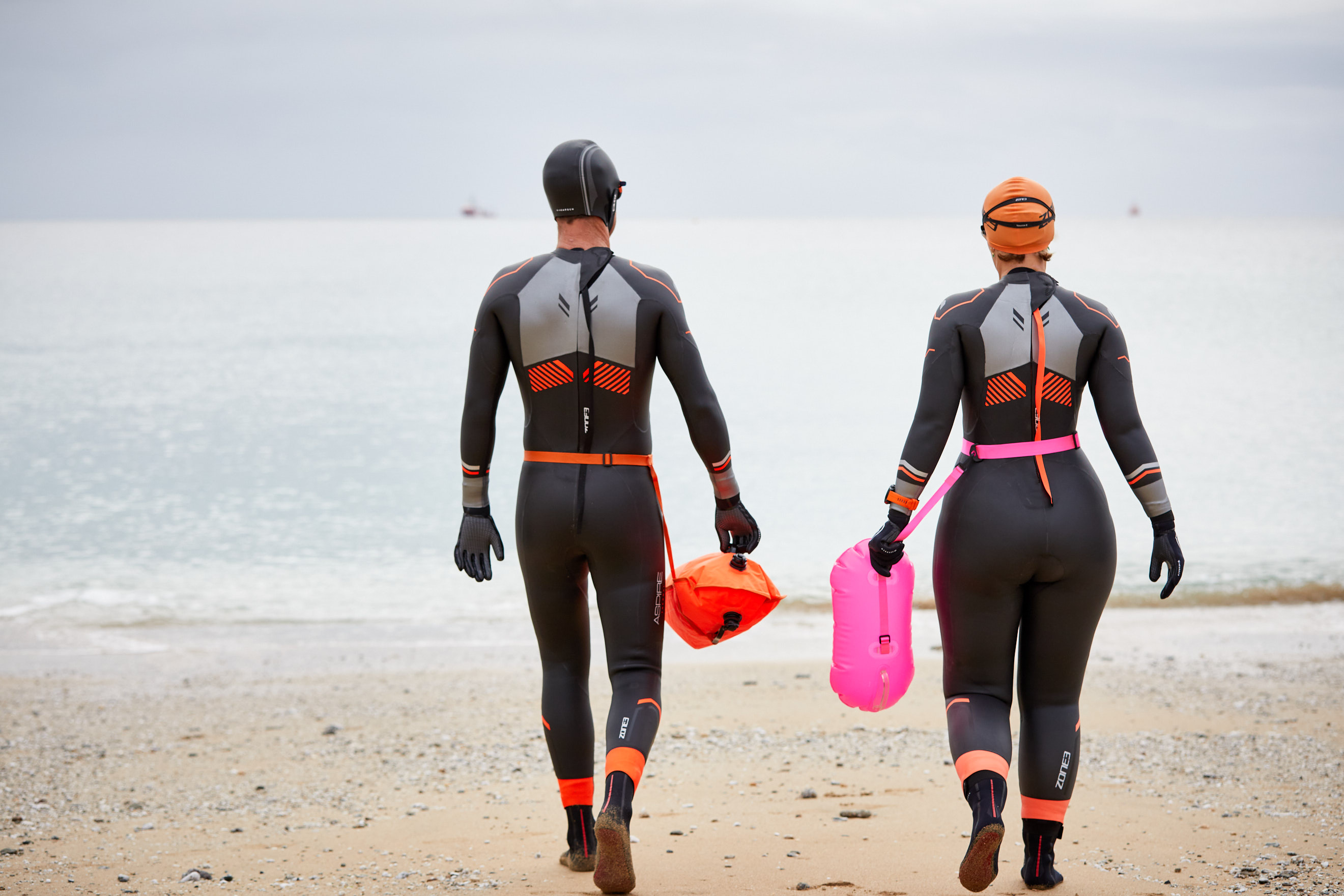How tight should a wetsuit be and will a wetsuit stretch?
Fit is king when it comes to choosing a wetsuit for open-water swimming and triathlon – but how tight should your wetsuit be and will it stretch? Here is all the info you need.

When choosing your first wetsuit for an open-water swim or to train for a triathlon, the choice can feel overwhelming. Start with fit first though and you won’t go far wrong!
Getting the right wetsuit fit
If you are buying a wetsuit for the first time though, it can feel quite alien.
Triathlon wetsuits feel quite different to surf wetsuits in that they are designed to really support your body during the swim stroke (usually front crawl, though some brands do offer wetsuits for front crawl now with different features).
So your wetsuit will be coated neoprene to help you slip through the water more easily as opposed to the more ‘fabric-feeling’ uncoated neoprene of a surf wetsuit.
It will have different thicknesses of neoprene depending on how much buoyancy it is creating for you and it will likely feel more close-fitting.

What happens if a wetsuit is too big?
This close-fitting feel is important and put simply, if a wetsuit is too big for you or allows any water ingress through the neck or cuffs, it will not do its job.
Swimming wetsuits work by allowing a tiny bit of water to enter, which then sits next to your skin and is warmed by your body heat. This layer of water (as well as the suit itself) is what they keeps you warm.
If your suit is constantly allowing water in, this will flush through the suit meaning your skin is constantly exposed to new cold water and you will not stay warm.
If a wetsuit is very big on you, not only will it allow water to flush through, but it will also affect your swimming, creating drag – and nobody wants to be slower on race day!
Just a quick note here on wetsuit fit for taller/shorter athletes here, too. Wetsuit fit tables usually work based on height and weight, but as with all these things they fit into a range, so you may find your wetsuit is a little long on the arms or legs.
If this is the case, chat to the shop or brand you bought it from and ask them whether the arms can be trimmed down (to prevent ruching at the wrists and ankles). Many wetsuits come with handy ‘cut lines’ already marked on the lining to make this easier.
If your wetsuit is too short in the arms/legs then you can wear it a little higher on the arms and legs (provided you have enough length in the body) and in fact many pros cut their wetsuits higher on the arms and legs to make removal easier.
The only trade-off here could be in colder water, as our wrists are very sensitive to temperature with blood vessels close to the surface. So consider carefully before trimming a suit down in this way!
Always think carefully before cutting a wetsuit though and seek advice if new to open-water swimming. Scissors plus neoprene equals making it very easy to ruin an expensive new wetsuit!
What happens if a wetsuit is too tight?
If your wetsuit is too tight, you will feel uncomfortable and restricted as you swim. Usually, you can spot that your wetsuit is too small as it will be very hard to get into (harder than usual!) and you may find it is difficult to get the crotch high enough on the body.
You may also feel like you are being ‘strangled’ by the suit and that breathing is more difficult, or that when you lift your arms above your head you cannot get enough stretch to reach properly.

All these things will impede your swimming and can leave you feeling fatigued come the bike leg of your triathlon. There is also a risk that a wetsuit which is too tight can be a contributing factor for SIPE (swim-induced pulmonary oedema) a condition which affects the lungs and breathing.
As for stretch in wetsuits, yes, they will give a little bit but not enough to compensate for buying a wetsuit which is too small for you.
Any stretch built in will be in the form of thinner, more flexible panels to allow you to move and a swimming wetsuit is not designed to stretch beyond the tolerances for fit and movement.
So it is better to start with a wetsuit that fits rather than buying smaller and hoping it will ‘give’. Neoprene doesn’t behave like denim!
How do I know if my wetsuit fits properly?
Different wetsuit brands and models will suit different swimmers, so it’s definitely worth visiting a wetsuit retailer if you can to try a few different suits.
Triathlon shops will offer these and many shops and open-water swimming venues will offer ‘fitting appointments’ where you can go along and meet an expert and try a few different suits, as well as receiving advice on which one fits you correctly.
If going it alone and/or ordering online, then carefully check your retailer’s returns policy and if you fall in between sizes, think about ordering a couple of suits to try on at home.
When trying your wetsuit, follow these steps to get it on, though obviously do not apply lube to a wetsuit unless you are 100% sure you will be keeping it!
It’s important to allow some time to put on a wetsuit and try not to do it when you are flustered or hot and sweaty. Also, make sure you always wear gloves (often supplied with the suit) to avoid nicking it.
Triathlon wetsuits stretch well, but are very easily damaged by sharp fingernails.
Once you have pulled the wetsuit on and zipped it up, think about how it feels. Can you breathe easily? Can you swing your arms without restriction?
You should also be able to turn your head without discomfort on your neck and the wetsuit should fit closely to your spine, allowing for any curvature along your back.
If the suit is sitting ‘proud’ of your back, then it is likely too short in the body and you will find it uncomfortable to swim in.
So how tight should it feel? Your wetsuit should feel close-fitting but not uncomfortable or overly-restrictive and you should be able to move in it.
Wetsuits do feel slightly looser once you get in the water and water is allowed into them, too.
What if I cannot find a good fit?
By their nature wetsuits are designed to fit a number of average body shapes and heights, so for some, it can be more tricky to find a wetsuit to fit. There are options here though, so don’t be discouraged!
Some triathlon brands have told us they will soon be launching more size options (more on this in 220 soon), which will allow more inclusion for larger and/or curvier swimmers, including Orca’s new open-water range.
We have been impressed by Lomo’s Prime wetsuit too, which as well as being a good budget option for beginners comes in sizes from women’s dress size 6-32 and men’s S-XXL.

Finally, another great option is to have a wetsuit made-to-measure by British brand Snugg, based down in Cornwall.
If you do a lot of swimming and want the perfect fit, this is a great option for any athlete and prices are comparable to an off-the-peg mid to top-end wetsuit. I had one made last year and you can read my Snug Slipsteam wetsuit review here.
- Best triathlon wetsuits for all budgets
- The top cheap wetsuits reviewed
- Best thermal wetsuits for swimming




